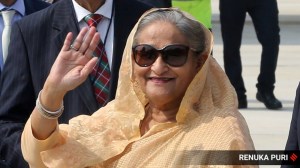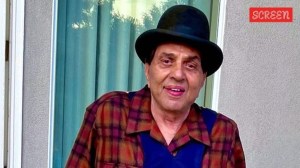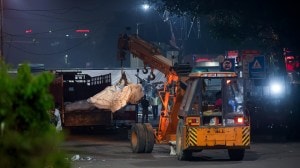Fashions Up and Coming
The maiden Shillong Fashion Week was an indication that the northeast fashion scene is ready to take off.
The maiden Shillong Fashion Week was an indication that the northeast fashion scene is ready to take off.
You know a city is ready for a fashion event when the chief minister of the state turns up at a show in a trendy suit and waits patiently for nearly two hours for it to start. Or,when a host of designers from across the country arrives to rub shoulders with their local counterparts at a nouveau fashion event,where business isnt the focal point,but showcasing handicraft and weaves are. The inaugural Shillong Fashion Week (SFW),held on October 19-20 at the North Eastern Hill University (NEHU),overcame beginners hiccups with a generous dose of enthusiasm and goodwill. The idea behind the event was not just to make Shillong the next fashion hub but to construct a bridge between the weavers of Meghalaya and fashion designers across the country. We have the strongest and most creative weavers in the country and this can become a more than profitable industry for the entire Northeast, said Mukul Sangma,chief minister of Meghalaya. Sangma is one of the states biggest patrons of fashion and his government is one of the organisers of the SFW.
At a time when the Northeast has been in the news for communal tension,the event was an interesting exercise in integrating indigenous textile traditions and its innovations with the so-called mainstream fashion narrative. The inaugural day saw an unusual blend in the audience apart from fashion followers,there were 200 traditional weavers from across Meghalayas seven districts whom the government had invited. Tapashree and Rajshree,sisters from a village of weavers in West Garo Hills,were impressed by what they saw. All the boys in our village work on the farms while we weave. We make around Rs 50 – Rs 100 per piece of cloth that we weave. Its nice to see how ingenuously the weaves have been used, said Tapashree.
Creative director of the SFW and consultant for sericulture and weaving to the government of Meghalaya,Nathaniel W Rynjah,says that is the kind of scope they want the weavers to be aware of. They should know what kind of products sell and the outstation designers should know the kind of textiles they can pick up from the Northeast. We have been trying to get the bigger designers to come and do cluster projects with the weaver communities. Delhi-based brand Abraham and Thakore (David Abraham and Rakesh Thakore) have agreed to come. They will take samples from the weavers and exhibit them for potential clients and buyers, says Rynjah.
Fashion is a unifying bond that runs through the region and people like Rynjah are quick to see it both as a business opportunity and an integrational exercise. He recently launched a multi-designer boutique,The Closet,in Shillong,which stocks clothes by outstation designers along with local talent and has tied up with Gurgaon-based fashion portal privatesales.com to give consumers in the region easy access to mainstream fashion. People across the states of the Northeast are really fashion forward. They are brand conscious and religiously follow trends. There is a large section of people that wants to buy designer clothes. They dont have access to it here,so they prefer to shop in Delhi. Its one of the reasons why online shopping is huge in the Northeast, he says. Plans are afloat for another multi-designer brand in Shillong,and Sangma has already given the go-ahead to a fashion week at Tura,the district headquarters of West Garo Hills,and his own assembly constituency. The Tura fashion week will be held next month and designer Neeru Kumar has already agreed to come, says Julie Deb,the managing director of the SFW.
With regular shows coming up in the region,it also means good news for models who have had to look elsewhere for work. While Sonalika Sahay from Assam and Esther Jamir from Nagaland have found success in the fashion circuits of Delhi and Mumbai,many others have found it difficult to find work because they look different. I work for a Delhi-based agency,where most of the other girls are foreigners. I have a tough time getting assignments because I look different. I even get paid less than the others, said former Miss Tibet Dolma Tenzing,a model who participated in the event. But Tenzing is hopeful that with more such fashion events coming up in the region,people like her will find better opportunities. Ramp shows are often a problem for us because of our height,but at least more Northeastern models are being booked for print ads,not just in the Northeast but in Delhi and Mumbai too, she says.
In many ways,the Northeast fashion script has already made an impressive impact on the Indian fashion industry,thanks to designers like Atsu Sekhose,Jenjum Gadi and Imchatsung Imchen,who blend tradition with modernity in their clothes. Young designers like Sophia Sangma,the niece of the CM,want to follow the same route to success. For her show at the event,she extensively used Meghalaya weaves as cut-work patterns in her collection. The fashion week was about showcasing the region,so while my silhouettes were western,I used traditional motifs and patterns, she said. Another Shillong-based designer,Elizabeth Marbaniang,played on the traditional drapes of the jainsem,an attire worn by women of Khasi and Khynrium communities. The jainsem involves interesting drapes. If you see international trends,drapes are now in focus. So there is huge potential for traditional Northeastern designs to be incorporated into mainstream and international shows, she says. Gadi,who hails from Nagaland,sums it up best: With events like the SFW,where people get to see more designers and models from the Northeast,its only a matter of time before the exposure leads to increasing opportunities for everyone.





- 01
- 02
- 03
- 04
- 05


























